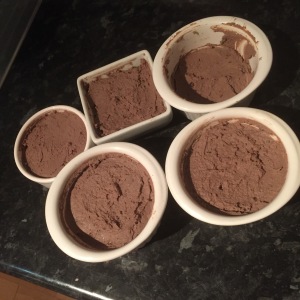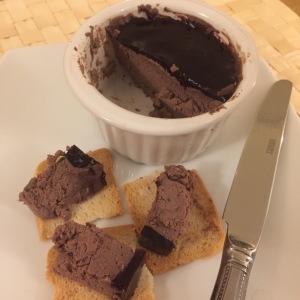#1 – 48 Recipe Challenge: Recipe 44 – Chicken Liver Parfait

The idea for this month’s recipe was born when the other half and I went out for dinner and he ordered Chicken Liver Parfait as a starter. This led to a conversation about the difference between a pâté and a parfait, which neither of us knew. I thought it would be to do with the ingredients – parfait is usually lighter and more mousse-like in texture, so I assumed it had cream added and was perhaps whisked to make it less dense.
But apparently not. Some pâté recipes have cream in, some don’t. Some websites suggest that a parfait is simply a pâté that is passed through a sieve to make it very smooth – whether before or after cooking. There also seems to be a debate about whether a pâté is cooked before it is assembled or afterwards e.g. is the method to cook the ingredients, blend the mixture (and possibly pass it through a sieve) before leaving it to set, or is the method to blend the ingredients, then cook the mixture in a bain marie. I came to the conclusion that basically both pâtés and parfaits are cooked first then set in the fridge, and anything which is blended before being cooked and set in a bain marie is actually a terrine. If you want to really confuse yourself though, check out this post: http://nandchef.blogspot.co.uk/2013/05/definition-of-pate-and-terrines.html
As I’d spent so long looking this up and reading different pâté recipes I thought I’d have a go at making one. It’s a good choice for the 48 Recipe Challenge because not only is it a method I’ve not used before, it’s also a new ingredient for me. Normally I won’t eat offal so I’ve never cooked with it but for some reason I have a particular love for Chicken Liver pâté. In addition to my dislike of offal, I had an idea that pâtés were difficult and time consuming to make, but having read through various recipes, it seemed that actually is wasn’t as difficult to do as I had imagined it might be.
Having tried it, I can safely say it certainly was not easy. Well, actually that’s not entirely fair. It wasn’t a difficult process per se, but it was time consuming. I had to trim the sinew off the livers (not a pleasant job, they’re really slimy), chop the shallots, crush the garlic, fry the livers, melt the butter to soften the onions and garlic in, deglaze the pan with brandy, add chopped herbs and blend the lot. As I had decided to make a parfait, I then needed to pass the mixture through a sieve. After 15 minutes of that and getting nowhere fast, I soon got bored; so out of five assorted sized ramekins I have managed to produce one of chicken liver parfait and four of chicken liver pâté…
Then I had to make the jelly for the top. Often pâtés are topped with butter but I’d found this recipe: http://pleasedontkissthecook.blogspot.co.uk/2012/12/chicken-liver-pate-better-late-than.html using a port jelly instead, which I thought sounded good. Pâté does need to be sealed with something (either butter or a jelly) because otherwise the surface oxidises, which both makes it go grey and therefore look unappetising but also affects the taste. I’m pleased to report that the jelly was very simple to make and poured easily onto the surface of the pâté before setting well in the fridge.
As you may have guessed, I didn’t enjoy the process of making the pâté. The part where I had to flambé the brandy to burn the alcohol off was fun, but I really disliked handling the chicken livers and everything took soooo long. What initially seemed a simple, straightforward recipe actually took me over 3 hours to complete, including the clearing up (and this does use quite a bit of equipment). If I’d continued with the ‘passing through a sieve’ lark to make it all into parfait I reckon it would have easily taken another hour at least! Even getting the pâté into the ramekins was challenging – it went all up the sides and was very difficult to smooth off.
So, my conclusion on this recipe is that I probably wouldn’t bother again. It took a lot of time, made a lot of mess and therefore is only worth it in my book if it produces something which tastes amazing. On the day I made it, this pâté was very dry and dense, and particularly ‘livery’. (When I say dry, think of that peculiar dryness that comes from fresh cranberries, where it sort of sucks all the moisture out of your mouth.) The pâté also had that really noticeable metallic tang that is everything I don’t like about offal. I was really disappointed, having put all that effort in.
The recipe said that the pâté improved with age, so on the following day I gamely gave it another go and to my surprise it was slightly more palatable; somehow less drying and less liver-y. Fingers crossed this trend continues over the next couple of days, otherwise given my dislike of offal, and the fact that I haven’t noticed a pronounced livery taste with commercial liver pâtés (which I actually really enjoy), unless this one improves dramatically in a short space of time I think I’ll stick with shop bought in future! (The port jelly is really good though, and the sweetness cuts through the dryness of the pâté.)
Scores for this one are:
Healthiness – 5/10 (not necessarily unhealthy but just under 300 calories a ramekin for what is essentially a side dish or starter is quite a lot, and that’s before you add any bread to spread it on)
Ease of prep – 3/10 (I really didn’t like handling the liver and there was a lot of equipment to clear up afterwards)
Flavour/taste – 4/10 (perhaps it was just this particular recipe but this is shaping up to be much too livery for me, far more so than commercial chicken liver pâtés)



